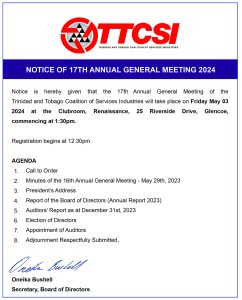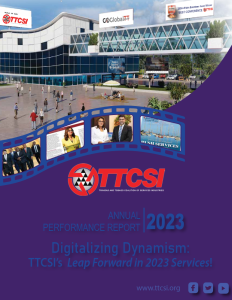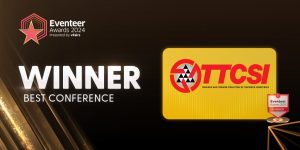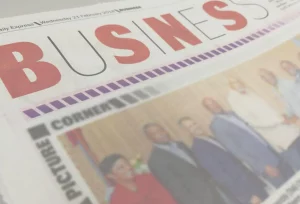ADDRESS BY
THE HONOURABLE CAROLYN SEEPERSAD-BACHAN
‘ENABLING THE MODERNISATION OF OUR PUBLIC SERVICE THROUGH E-GOVERNANCE’
TRINIDAD AND TOBAGO COALITION OF SERVICE INDUSTRIES
SALUTATIONS
Cabinet Colleagues; The Hon. Prakash Ramadhar, Minister of Legal Affairs,
Dr. The Hon. Tim Gopeesingh, Minister of Education.
President of the Trinidad and Tobago Coalition of Service Industries, Mr. Rabindra Jaggernauth
Board of Directors of the TTCSI
CEO of the TTCSI, Mr. Nirad Tewarie
Keynote speaker, Mr. Aneesh Chopra
President, InvesTT, Mr. Kelvin Mahabir
Executive Officer, TATT, Mr. Kamachand Perai
Ms. Gillian Macintyre, Permanent Secretary in the Ministry of Public Administration
Mr. Richard Madray, Deputy Permanent Secretary in the Ministry of Public Administration
Ladies and gentlemen,
Members of the Media
Good morning.
First, let me compliment the Trinidad and Tobago Coalition of Services Industries (TTCSI) and its extremely hardworking executive for coming up with the idea of a week of activities that focuses on the importance of the services sector to the economy.
A recent World Bank report has stressed that the efficiency of the service sectors is an important determinant of the productivity of other industries, whether in manufacturing or agriculture, as well as in other services. From my perspective as Minister of Public Administration, the public sector is also a service industry and increasingly must be perceived, managed and evaluated the same way we manage other service industries. In fact, the public service is the biggest service industry in Trinidad and Tobago.
Today is the fifth annual celebration of National Services Week and I would like us to give the TTCSI a well-deserved round of applause. The theme “Staying Ahead Of The Curve” forces us to examine our present plans, policies and projects from the point-of-view of the future. The key to staying ahead of the curve is innovation – both in thought as well as deeds – focusing on new ideas, new products and new ways of looking at the world.
It is good to see that even though the TTCSI is just six years old this month you have already started looking at the future and what you need to do to gain a competitive advantage both as individual organisations and as a group. I wish you well in your pursuit of opportunities for future growth and offer my assistance, as Minister of Public Administration in whatever ways I can help.
One thing you should note is that the Public Service as a group is the largest consumer of goods and services in Trinidad and Tobago. You may wish to review your business and strategic plan to see how TTCSI and its members can access this market especially as the public service is becoming increasingly technology-intensive and is more-and-more reliant on outsourcing. There is a lot of common ground here that we can explore.
Also, I want to thank the TTCSI for inviting me to deliver the Keynote Address at this morning’s forum on Unleashing ICT For Development. I must confess that I would have been here anyway. I am extremely interested in what Mr. Chopra and the other speakers have to say. Mr. Chopra’s credentials in this field are impeccable – in fact they are outstanding.
He has left a legacy at the White House and built a foundation that are both enviable and substantial. We have a lot to learn from him as we focus on what is my topic today and primary preoccupation as Minister of Public Administration for the foreseeable future. It is, “Enabling the Modernisation of our Public Service through eGovernance”.
Before I deal with the concepts of eGovernance and public service modernization, and look at the synergy and symbiosis between them, I want to talk a little about another concept that has helped us reach the point where today we can link eGovernance and public service modernization.
It is the concept of “convergence”. We can say, in a sense, that this morning a lot of different people from different parts of Trinidad and Tobago have all converged on the Hyatt to see and hear Mr. Chopra. While this is physical convergence, it illustrates a movement, a convergence, that has been taking place since the development of Information and Communications Technologies or ICTs which has exploded during the past few years.
There are different types of convergence but the one we are talking about is specifically in the area of ICTs. Technological convergence is the tendency for different technological systems to evolve toward performing similar tasks. This is what has happened as previously separate technologies such as voice, data and video now share resources and interact with each other synergistically. The mobile phone is a classic example of convergence and my classic example of public service modernization or “transformation” as we call it.
Our dream and our evidence that we have a truly transformed public service is the day when a citizen in any part of the country can use a cell-phone to access any government service or several services at the same time, provide inputs into public policy, ask to see the up-to-date expenditure on any project, or to perform that most fundamental of democratic functions – to vote!
This can only happen when all our measures at transforming the public service converge, and at the same time, harness the power of the converging ICTs to create an e-Governance model that is truly citizen-centric.
We already have one component of this synergistic triangle in “SMART” phones in which a lot of different technologies have converged. You have internet, text, email, video and a lot of different integrated features. “Smart” as used in the term “smart-phone” is not a value judgment – it is a capacity indicator. In other words “smart” in this sense of a smart-phone is not how much you know but how many different things you can do at the same time. If we use “smart” as it is now used for technology and apply it to our country’s needs, our challenge is to create, facilitate and empower a “smart” public service and “smart” citizens. This combination – technology, a transformed public service and a free, informed and independent citizen is what eGovernance is all about. A citizen-centric society is the result of the convergence of all three forces of technology, people and the public sector within a democratic setting.
Some people use the term eGovernment and eGovernance interchangeably. The United Nations or UN defines “E-Government” as ‘The employment of the Internet and the world-wide-web for delivering government information and services to the citizens.’” However, we want to do more than inform citizens, we want to involve them.
This is where eGovernance comes in. While e-Government is centered on the operations of government, e-Governance extends the scope by including citizen engagement and participation in governance. E-government is a one-way communication protocol whereas E-governance is two-way. It is interactive and the processes on which it is based like the “one-stop” shop are interactive. The processes are the medium between the people and the public service and they are two-way instead of one way.
Public service transformation has been called many different names – reform, modernization, transformation – and has been here with us since the colonial days. Our present public service was born when our nation became independent. It is now fifty years old and, like our country, is celebrating its Golden Jubilee. Within these fifty years there have been numerous attempts to modernize and transform the public service. None of the measures taken has been either successful or sustainable. Why?
The technological infrastructure, the ICTs, was not in place. However, in the 21st Century, we have invested in ICT. There has been a tremendous amount of investment in the ICT Sector, in the Government, the public service and in the private sector. Why do we have so little to show for it? In my view, the reason for this is that we have had a lot of investment in ICT but at no point did we engage Public Service Transformation to embed ICT into its processes. We, now, have to ensure the two concepts public service transformation and e-Governance must now converge because the ideas, implementation possibilities and infrastructure have now converged.
Having acquired or are acquiring most of the technologies we need, and with the process of assimilation underway, the next stage is the application process which involves institutionalizing the changes and then internalizing them. The application process means having the processes in place and in use. We call this the “Diamond” standard and our efforts to further merge public service transformation and eGovernance to achieve this goal are already underway.
In all discussions about public service transformation there is and has always been the issue of integration. Public services are most effective when they work together in an integrated manner. In fact the Government is also engaging in clustering for Public Service, as the g-government platform allows for clustering. The big outcomes, the overarching goals – better quality of life, greater economic performance, increased competitiveness, better health, less corruption, improved ease of doing business, access to public goods and services- can only be achieved in partnership.
Integrated services are easier to access and use, and they are far more efficient to deliver. We can now integrate existing services and even build-in the capacity to incorporate future services using the available and emerging technologies that drive e-Governance mechanisms. With regards to E-Payments, the Minister of Legal Affairs has indicated that the E-Payment legislation will be before the Parliament before the end of the year.
The combination of eGovernment, eGovernance and Public Service modernization has shown to be extremely effective. An Australian study has demonstrated that the convergence of all three variables has resulted in improved service delivery, reduced consumer costs, more social benefits and greater user benefits including significant improvements in the ease of acquiring information, service quality and the ability to make better decisions. Even more significant is that more than fifty percent of the people surveyed experienced improvements in work or business opportunities. The Government agencies involved also benefit from improved business processes, lower service costs and from cross-agency collaboration through multi-channel access and one-stop shops.
There are other examples in several other countries and it is quite clear that if you integrate services and facilitate access through harnessing the growing power of ICTs you will succeed. All the different models that are evolving are really eGOV models and it does not matter whether the “GOV” stands for “Government”, “Governance” or both.
Let us now look at the issues we are facing and the approaches we are taking to public service transformation and eGovernance. First, let us look at the challenges.
The first and major challenge is what I call the weight of expectations that rests heavily on the backs of the public service everywhere. Citizens increasingly expect value for money. They value their time and realize that long delays in accessing and enjoying public services are opportunity costs. They see public goods and services, not as gifts of a benevolent government, but as rights to which their votes and tax dollars entitle them. They want and deserve the best service of the highest quality in the shortest time at the lowest cost regardless of race, colour, creed, class, status or geography. They want a level playing field and equitable treatment. Many feel marginalized. They want to have a greater say in those matters that affect them. They want to be in touch with their elected representatives all the time and not just at election time.
Public servants also have their needs, concerns and expectations, the first and most important of which is a fair, objective, transparent, comfortable and safe working environment in which they have some control over the fruits of their labours. They want an environment that encourages and supports mutual trust, respect, rewards and recognition. Most of all, they want to be communicated with and not talked down to or ignored. In a sense they are saying if you want us to treat our clients as people you have to treat us as people too.
When it comes to eGovernance, public officers and the Government are on the same wavelength. Our public officers have told us that the structure of the public service needs to change to incorporate technologythatisavailable. This is the most significant and useful building block for the future.
The next is how we view the public service – is it a drain on the economy or is it potentially a significant contributor to the economy?
Our approach is to treat the Public Service as a business whose business it is to provide the best service possible to all our citizens, now and in the future. We see publicadministrationacross theentire publicservice, in every agency of Government, in every office in every region,asa business. This business orientation says that the public service has amandateforimproving theease of doingbusiness.
It has a duty to improve ourcompetitiveness, reduce actualcosts, lower opportunity costsandensurethat our citizens, includingthe public officersthemselves,can getthe best possibleservice intheshortestpossible time,atthelowestpossiblecostandatthe highestpossible quality.
Ifyouagreewithmethatthepublicserviceis abusinessthatcouldbenefitfrom thebusinessapproachandprofitfrombusiness orientation,thenyoumust alsoagreewithme that it iseverybody’sbusiness. What makes the public service even more a business is that the public service is the biggest procurer of goods and services in this country. It needs to outsource much of what it needs to conduct its own business so that it provides business opportunities to the private and voluntary sectors, big- and small businesses alike from caterers to consultants.
The second step we are taking is to review the processes, procedures, policies and products of the public service with particular emphasis on Human Resource Management. We have been meeting with the key public service agencies to get their views on what we see as the way forward and have also met with the Trinidad and Tobago Publishers and Broadcasters Association, the Public Service Commission and the Teaching Service Commission. In the next few weeks we will have meetings with at least ten civil society groups throughout the country, particularly from our rural areas, to get their views about different aspects of public service transformation.
Last year we developed a Green Paper which laid out an approach to public service transformation. It did not cover the entire public service. Early next year we will be releasing for public comment a Draft White Paper on Public Service Transformation which will be more comprehensive and more extensive. It will be our roadmap from where we are now to where we want to be, and those policies, mechanisms, approaches and specific activities that will get us to where we want to be with modernisation. Needless to say, the underlying philosophy of the White Paper will be one of inclusion and this is because it is the way to go and eGovernment as both a strategy and a platform makes this possible.
We know none of these approaches by itself will take service delivery to the level that we want. Among the processes that will help bridge the gap between the public service and the people will be “one stop shops”, multi-channel delivery systems and other mechanisms that foster and encourage stakeholder participation in all aspects of service delivery from concept to completion. This is where the convergence of ICTs and public service modernization takes place.
Information and Communications Technologies (ICTs) are the hub and wheel of citizen centricity. They are the backbone and the feet that will take us to the future, as well as the portals or gateways that open into the information superhighway. Broadband is the way to go and it must develop simultaneously with improvements in service delivery or even precede them. Let me inform you that before the Ministerial Team is the Broadband plan which was developed nine month as ago and had been commented upon by the World Bank. The implementation of this plan will see the roll out throughout Trinidad and Tobago, ad with the Universal Service fund there will be affordable access to Broadband including rural areas.
We have already reached far in the eGovernment area. There is already a “backbone” and a “portal” that serves most of the central government. In terms of the services offered by my Ministry, citizens can access information, download forms, apply for scholarships and conduct some transactions online. The eGovernance part, the two-way, interactive communication between public officers and citizens is where we now need to move forward as public service modernization cannot happen without it.
In fact, the E-Governance platform is allowing many Government Agencies and Departments to establish Service Charters. The Ministry of Public Administration is working with several agencies to have their service charters rolled out in the very near future. These include the Ministry of Education, Examinations Division; the Ministry of Housing, Housing Grants; and the Ministry of the People and Social Development. The Scholarship and Advanced Training Division, of the Ministry of Public Administration is the first Division in the Public Service to launch a service charter underlining its commitment to excellent customer service. If the Divisions cannot deliver according to these service charters, the Ministry will have a penalty to face.
Ladies and gentlemen, I have tried to lay out for you the way we are already enabling the modernisation of our public service through eGovernance and what more we can do, and how much more we can achieve, as we move forward. I have also pointed out the need for more engagement with civil society and with groups like the TTCSI.
I have stressed the need for looking at the public service as a business which we all own, which we all patronize and which exists to service the needs of all the citizens. It is important that we are all, literally, on the same wavelength. To put it another way we- and by we, I mean the public service, the Government, the private and voluntary sectors – we must all read from the same page.
In the old days we literally had to print a copy of that page and hand it out to everyone. Now we can all experience the same page at the same time and can comment on it and respond to it. We can acquire, assimilate and apply the information on the page at the same time. This is the power of ICTs and it is this rapidly expanding power channeled into a responsible interactive mechanism called eGovernance that will help us to achieve the SMART or S-M-A-R-T goals of a citizen-centric public service. Simple, Moral, Accountable, Responsive and Transparent.





